Volume 40 Number 4
COVID-19: impact on ostomy and continence care
Karen Spencer, Stacy Haddad and Renee Malandrino
Keywords ostomy, COVID-19, peristomal skin, intermittent catheter, bladder care, continence care, discharge program, Secure Start services, virtual, Hollister
For referencing Spencer K et al. COVID-19: impact on ostomy and continence care. WCET® Journal 2020;40(4):18-22
DOI https://doi.org/10.33235/wcet.40.4.18-22
Abstract
Introduction The COVID-19 pandemic has changed our world. It has impacted all healthcare professionals (HCPs), organisations and the people they serve in multiple ways. This includes the specialty area of nursing in ostomy and continence care. During this time, it is important to know what can be done to support clinicians and patients (end users) through understanding what they are experiencing and how they are adapting to this pandemic.
Objective To gather research which describes the impact COVID-19 has had on clinicians and people with an ostomy or intermittent catheterisation requirements.
Methods The research was conducted virtually to keep patients, clinicians and researchers safe but enable important learnings. Research modalities utilised were surveys and an observational study.
Results This COVID-19 research shows that 57% of ostomy end users in the US and UK report peristomal skin issues in the past month. What has caused more concern is that 84% of ostomy end users report NOT contacting a HCP about their skin issues. In continence care, 49% of intermittent catheter (IC) users are more concerned about urinary tract infections (UTIs).
Despite these challenges, many ostomy end users (52%) and IC end users (37%) report not knowing if telehealth is an option for their care. Instead, this research shows that end users are accessing more information online – ostomy end users increased their online usage by 34% and IC end users by 50%. Both groups report the information they are seeking the most are tips for troubleshooting issues and information about the availability of their ostomy and continence products. This matches the ostomy nurse survey results that indicate clinicians are seeking information on ostomy education and product availability.
Conclusion Early research suggests that ostomy and continence care patients alike are being negatively impacted by the COVID-19 pandemic. As this is only the beginning of the global pandemic, much more research is needed.
Introduction
On 19 March 2020, the World Health Organization (WHO) declared COVID-19 a pandemic. The WHO1 defines a pandemic as a global spread of a new disease. The Centers for Disease Control and Prevention (CDC)2 says the term pandemic refers to when viruses “are able to infect people easily and spread from person to person in an efficient and sustained way in multiple areas. Because the virus is new to humans, very few people will have immunity against the pandemic virus, and a vaccine might not be widely available”.
No one was prepared for such a change in such a short timeframe. As a clinician, one cannot help but wonder how the current COVID-19 crisis has affected, and will continue to affect, the specialty area of nursing in ostomy and continence care. The COVID-19 pandemic that is sweeping across the globe has impacted all healthcare professionals (HCPs), organisations and the people they serve in multiple ways.
You may now lack the resources needed to confidently conduct your practice, and there may be a new expectation to learn as you go. Changing direction, adapting and considering alternative strategies will continue to demonstrate your dedication to the care you provide.
The ostomy and continence community is also very understandably concerned how the COVID-19 outbreak is affecting their daily lives, their access to healthcare and support networks and, very importantly, to their access to ostomy and continence care supplies.
During this time of crisis, it is important to know what can be done to support the profession of ostomy and continence nursing and the people they serve by clearly understanding what clinicians and their patients are experiencing and how they are adapting to this pandemic.
Methods
Several research modalities were utilised to gather information on how COVID-19 has impacted ostomy patients, intermittent catheter (IC) patients and clinicians; Table 1 outlines a description of the research methods and populations of interest. All of the research was conducted virtually to keep patients (end users), clinicians (nurses) and researchers safe but enable important learnings.
Table 1. COVID-19 research methods

* Hollister Incorporated internal data on file
**Due to missing data, the number of responses to specific questions varies
***Response rate not applicable as this is a longitudinal study not a cross-sectional survey
The research described is quantitative surveys and a patient registry. The end user surveys were all conducted online and included 12 to 19 closed ended questions. The clinician survey was conducted online and included eight closed ended questions and one open ended question. Survey research is a useful research method that has clear benefits in helping to describe and explore variables of interest8. Patient registries, if properly designed, can provide a real-world assessment of patient outcomes, clinical practice and product safety9. The ostomy patient registry was undertaken to assess the longitudinal impact of ostomy product use on stoma-related cost of care, resource utilisation, quality of life (QoL), peristomal skin health, overall product satisfaction and other factors5. As such, the study contains a variety of questions and product users. Only two categories were assessed for the impact of COVID on responses – the reason for barrier change and barrier wear time. This study is currently enrolling in the US and is expanding into UK and Canada. The abbreviated list of areas researched within the above methods are described in Table 2.
Table 2. COVID-19 research areas

Results
The shift to virtual care
During COVID-19, many people are not seeking medical attention by going to a doctor’s office, attending an outpatient clinic or seeking emergency care at the hospital in fear of contracting COVID-19. These fears or social distancing recommendations may prevent people with ostomy or continence challenges from seeking assistance when they are having peristomal skin complications or urinary tract infections (UTIs). In one survey7 with IC end users in the US, 44% of the 57 respondents felt that their bladder care had been neglected due to a healthcare shift to focus on COVID-19. In an UK and US ostomy survey6 about 20% of 319 respondents felt the same about their ostomy care. In addition, the number of people having an in-person visit with a nurse (i.e. at an outpatient clinic) in the year prior to COVID-19 versus since COVID-19 dropped from 86% to 43% with IC end users7 and 31% to 5% with ostomy end users3. Ostomy and continence care nurses must therefore consider alternative ways of providing care to their patients during this time of crisis.
Telemedicine has emerged as a life-saver for the COVID-19 crisis, enabling patients to obtain care virtually. In a study at a large healthcare system in the US, which was an epicentre for COVID-19, video-enabled telemedicine in urgent care increased from 102.4 visits per day to 801.6 visits per day. This was a 683% increase in virtual care experiences10.
There are many benefits to virtual visits, including limiting person-to-person transmission of the virus, increased availability in a clinicians’ schedule to see more patients, providing care in patients’ homes and reduced travel costs for the patient. In a project at the University of Alabama, determining the feasibility of virtual postoperative visits, 90% of the patients “felt these visits helped with ostomy management”11. However, as Figure 1 shows, many ostomy end users (52%)6 and IC end users (37%)7 report not knowing if telehealth is an option for their care.
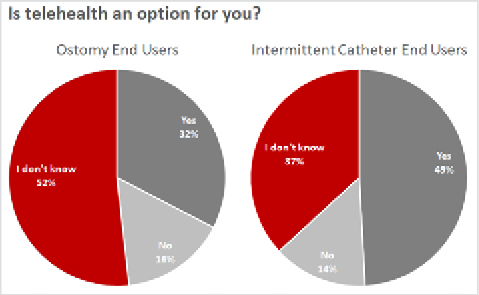
Figure 1. Telehealth usage with ostomy and IC end users during COVID-19
Ostomy management challenges
During COVID-19, research shows that 57% of end users in the US and UK continue to report peristomal skin issues in the past month (Figure 2)3,6. This high rate is congruent with pre-pandemic research12,13. What has caused more concern during this time is that 84% of ostomy end users report NOT contacting a HCP about their skin health problems, with 71% citing they did not feel the skin issues were serious enough (Figure 3)3. Furthermore, over one third of ostomy end users did not contact their HCP because they felt skin health issues were ‘normal’ for them.3 Unfortunately, even a mild to moderate peristomal skin complication may affect the QoL of a person with an ostomy14.
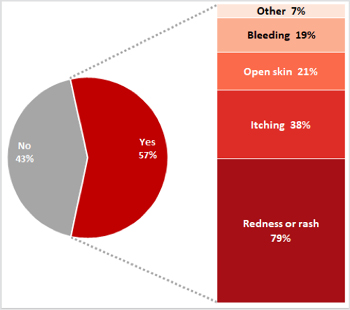
Figure 2. Peristomal skin complication occurrence and types of issues during COVID-19
Note: Ostomy end users were allowed to choose multiple types of skin issues
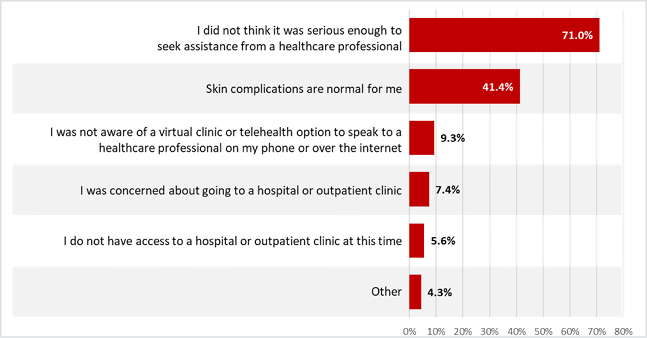
Figure 3. Reasons ostomy end users did not seek HCP support for their peristomal skin complications during COVID-19
From a cost perspective, the main treatments utilised by ostomy end users in the recent survey to treat their peristomal skin were changing the barrier more frequently and using more accessories6. However, the ostomy patient registry data, which reflects real world experiences and includes data from 3 months prior to the declaration of the COVID-19 pandemic through to June 2020, suggests that barrier changing reasons and wear time have remained stable for the 70 ostomy participants to date5.
Understanding the impact of peristomal skin complications will help clinicians adjust their practice to prevent and manage these skin complications quickly to help reduce the cost and QoL impact.
Bladder management challenges
In a July 2020 survey7 of 57 IC users, 49% of them were more concerned about experiencing a UTI. In addition, about 20% of these end users encountered product access issues, including needing more catheters per day and glove shortages during COVID-197.
Digital support
Through highs and lows, people living with an ostomy or continence issues have benefited from in-person peer support. Unfortunately, there are times – such as during a pandemic – when meeting face-to-face isn’t possible and people need to turn to online support. One of the recent COVID-19 surveys shows that end users are accessing more information online – ostomy end users increased their online usage by 34%6 and IC end users by 50%7. Both types of end users report the information they are seeking the most during COVID-19 are tips for troubleshooting issues and information about the availability of their ostomy and continence products3,7. This matches the ostomy nurse survey results that indicate clinicians are seeking information on ostomy education and product availability during COVID.4 End users seek this information mainly from general medical or disease websites, manufacturing company websites, ostomy association websites and supplier websites (Figure 4)3,7.
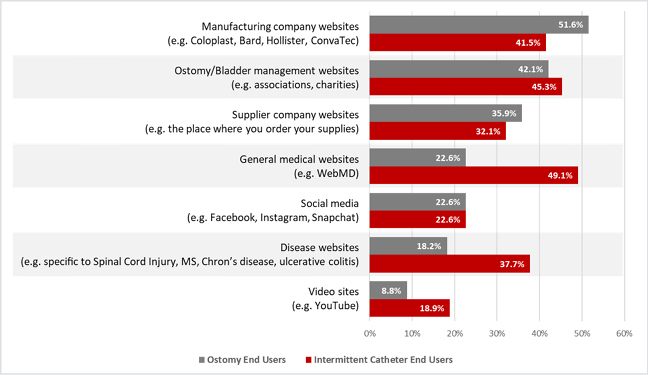
Figure 4. Types of internet resources utilised by ostomy and IC users for ostomy/bladder management information or support during COVID-19
Note: A total of166 out of 378 (44%) end users did not utilise any of the resources listed above. The percentages in the graph are based on the remaining 212 end users (159 ostomy and 53 IC).
Patient program support
Fortunately, in addition to COVID-19 support through virtual clinical care (e.g. telehealth), there are other virtual services available to help ostomy patients. Patient programs or support programs, such as Hollister Secure StartTM services, provide much needed support to people living with ostomy and continence care issues. These services have been uninterrupted through the pandemic and patients are utilising the service more than ever. Although COVID-19 has made social distancing a way of life, patient programs are more committed than ever to shorten the distance between the patient and educational resources and product information they need.
Websites also provide a helping hand for people living with an ostomy and continence issues during COVID-19. As many patients are accessing information online, having the right information available online is critically important – websites that focus on the information needed during this time to help achieve positive outcomes for patients. For example, many manufacturing company websites (such as the Hollister COVID-19 HUB) have specific information focusing on the needs of the HCP and end users during the COVID-19 pandemic.
Conclusion
In conclusion, early COVID-19 research suggests that ostomy and continence care patients alike are being negatively impacted by the pandemic. For ostomy patients, peristomal skin issues remain prevalent. In continence care, UTIs are a significant concern of IC users. For both patient populations, telehealth usage is low. This is an opportunity for clinicians to pivot their practice and include virtual support as an option for their patients. Both clinicians and end users display high engagement in research which helps identify what support and services they need during this pandemic. As this is only the beginning of the global pandemic, much more research is needed, including the effectiveness and satisfaction of online support or telehealth for these populations. The authors encourage readers to conduct their own research and share with the broader community. COVID-19 has challenged each and every one of us uniquely but, together, we can make a difference.
Ethics
Research was conducted through anonymous surveys and an ethics approved clinical study. The end user and clinician surveys were not in scope for ethics reviews. All research included participant consents.
Acknowledgements
A special thank you to George Skountrianos for statistical support.
Conflict of interest
Authors are employees of Hollister Incorporated.
Funding
Research was funded by Hollister Incorporated.
COVID-19:对造口和失禁护理的影响
Karen Spencer, Stacy Haddad and Renee Malandrino
DOI: https://doi.org/10.33235/wcet.40.4.18-22
摘要
引言 COVID-19大流行改变了我们的世界。它以多种方式影响了所有的专业医护人员(HCP)、组织和他们所服务的群体。这包括造口和失禁护理的专业护理领域。在此期间,通过了解临床医生和患者(最终用户)正在经历的情况以及他们如何适应这一大流行,进而了解可以采取哪些措施来支持他们,这一点至关重要。
目的 收集描述COVID-19对临床医生和造口患者或有间歇性导尿需求的患者的影响的相关研究。
方法 研究以虚拟方式进行,以保证患者、临床医生和研究人员的安全,但同时也能获得重要的知识。所采用的研究方式是调查和观察性研究。
结果 本次COVID-19研究显示,在过去一个月里,美国和英国有57%的造口产品最终用户报告了造口周围皮肤问题。更令人关注的是,84%的造口产品最终用户报告称其没有就皮肤问题联系HCP。在失禁护理方面,49%的间歇性导尿管(IC)用户更担心尿路感染(UTI)。
尽管存在这些挑战,许多造口产品最终用户(52%)和IC最终用户(37%)报告称其不知道远程医疗是否是自身护理的一个选择。但是,这项研究表明,最终用户正通过在线获取更多信息 - 造口产品最终用户的在线使用率增加了34%,IC最终用户的在线使用率增加了50%。两组用户均报告称,他们最想寻找的信息是对问题进行故障排除的建议,以及有关造口和失禁护理产品供应的信息。这与造口护士调查的结果相吻合,该结果显示临床医生正在寻找关于造口教育和产品供应方面的信息。
结论 早期研究表明,造口和失禁护理患者均受到COVID-19大流行的负面影响。由于这仅仅是全球大流行的开始,因此还需要更多的研究。
引言
2020年3月19日,世界卫生组织(WHO)宣布COVID-19为大流行。WHO1将大流行定义为一种新疾病在全球范围内传播。美国疾病控制与预防中心(CDC)2表示,大流行一词指的是病毒“能够轻易地感染人,并在多个地区以高效和持续的方式在人与人之间传播的状态。由于对人类而言,这种病毒是新病毒,因此只有极少数人对大流行病毒有免疫力,而疫苗也可能无法广泛提供”。
没有人对在如此短的时间内发生的这样的变化做好准备。临床医生,不禁想知道,当前的COVID-19危机已经如何影响并将如何继续影响造口和失禁护理的专业护理领域。席卷全球的COVID-19大流行已经以多种方式影响了所有的专业医护人员(HCP)、组织和他们所服务的群体。
您现在可能缺乏自信地进行工作实践所需的资源,而且现在可能有一种新的期望,即一边向前走一边学习。您需要改变方向、进行适应并考虑替代策略,这样将继续展现您对所提供护理服务的投身奉献。
可以理解的是,造口和失禁群体也十分关注COVID-19的爆发如何影响他们的日常生活、他们对医疗服务和支持网络的获取,以及非常重要的一点,即如何影响他们对造口和失禁护理用品的获取。
在这一危机时期,通过清楚地了解临床医生及其患者正在经历的情况以及他们如何适应这一大流行,进而了解可以采取哪些措施来支持造口和失禁护理专业及其所服务的群体,这一点至关重要。
方法
采用多种研究方式收集COVID-19如何影响造口患者、间歇性导尿管(IC)患者和临床医生的相关信息;表1概述了研究方法和目标人群描述。所有的研究均是以虚拟方式进行,以保证患者(最终用户)、临床医生(护士)和研究人员的安全,但同时也能获得重要的知识。
表1.COVID-19研究方法

* 好利斯特公司内部存档数据
**由于数据缺失,对具体问题的回复数量有所不同
***因为这是一项纵向研究,而不是横断面调查,所以应答率不适用
所述研究为定量调查和患者注册研究。最终用户调查均在线进行,包括12至19个封闭式问题。临床医生调查在线进行,包括8个封闭式问题和一个开放式问题。调查研究是一种有用的研究方法,在帮助描述和探索目标变量方面有明显的益处8。如果设计得当,患者注册研究可以提供患者结局、临床实践和产品安全性的真实世界评估9。造口患者注册研究是为了评估使用造口产品对造口相关的护理成本、资源利用、生活质量(QoL)、造口周围皮肤健康、整体产品满意度等因素的纵向影响5。因此,该研究包含多项问题和产品用户。对于COVID对回答结果的影响,仅评估了两个类别 - 底盘更换原因和底盘佩戴时间。这项研究目前正在美国招募受试者,并正在向英国和加拿大扩展。使用上述方法研究的领域的简略列表见表2。
表2.COVID-19研究领域

结果
转向虚拟护理
在COVID-19疫情期间,许多人因为害怕感染COVID-19病毒而不去医生办公室、门诊就医或去医院接受急救护理。这类恐惧感或有关保持社交距离的建议可能会阻止造口或失禁患者在出现造口周围皮肤并发症或尿路感染(UTI)时寻求帮助。在一项针对美国IC最终用户的调查7中,在57名受访者中,有44%的受访者认为,由于医疗服务重心转向COVID-19,他们的膀胱护理被忽视了。在一项英国和美国的造口产品用户调查6中,在319名受访者中,约有20%的受访者对他们的造口护理持同样的看法。此外,COVID-19爆发之前的一年中向护士当面就诊(即在门诊)的人数与COVID-19爆发以来的一年中相比,IC最终用户7人数从86%降至43%,造口产品最终用户3人数从31%降至5%。因此,造口和失禁护理护士必须考虑在此危机时期为其患者提供护理的替代方式。
远程医疗已经成为COVID-19危机中使患者能够以虚拟方式获得护理的“救命稻草”。在美国的一个大型医疗系统(该系统处于深受COVID-19影响的地区)进行的一项研究中,紧急护理中的视频远程医疗从每天102.4就诊人次增加到每天801.6就诊人次。这表明虚拟护理经历增加了683%10。
虚拟就诊有许多益处,包括限制病毒的人传人;增加临床医生日程安排的利用率,以便为更多的患者看诊;在患者家中提供护理;以及减少患者的出行费用。在阿拉巴马大学的一个项目中,确定了虚拟术后就诊的可行性,90%的患者“认为这些就诊对造口管理有所助益”11。然而,如图1所示,许多造口产品最终用户(52%)6和IC最终用户(37%)7报告称其不知道远程医疗是否是自身护理的一个选择。
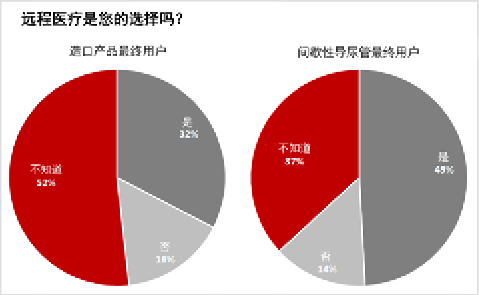
图1.在COVID-19疫情期间造口产品和IC最终用户的远程医疗使用情况
造口管理的挑战
在COVID-19疫情期间,研究显示在过去一个月里,美国和英国有57%的最终用户继续报告了造口周围皮肤问题
(图2)3,6。这一高发生率与大流行前的研究12,13一致。更令人关注的是,在这段时期,84%的造口产品最终用户报告称其没有就皮肤健康问题联系HCP,71%的用户称他们不认为皮肤问题足够严重(图3)3。此外,超过三分之一的造口产品最终用户没有联系自己的HCP,因为他们认为皮肤健康问题对他们来说是“正常的”3。但是,即使是轻度至中度的造口周围皮肤并发症也可能影响造口患者的生活质量(QoL)14。
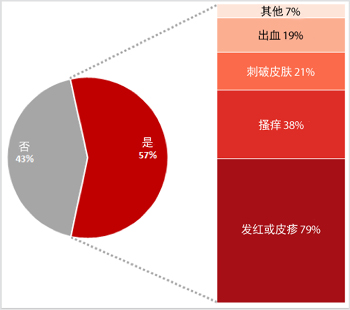
图2.在COVID-19疫情期间造口周围皮肤并发症的发生率和问题类型
注:造口产品最终用户可选择多个类型的皮肤问题
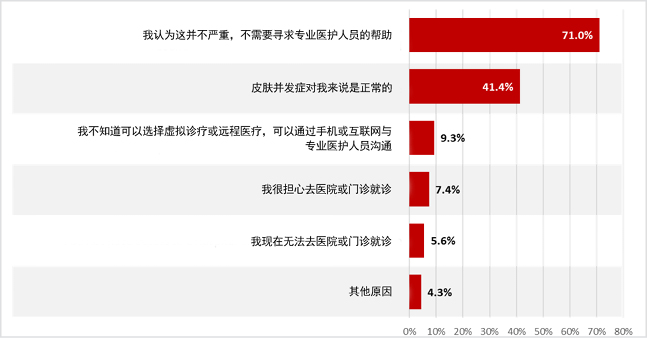
图3.在COVID-19疫情期间,造口产品最终用户未就其造口周围皮肤并发症寻求HCP支持的原因
从成本角度来看,在最近的调查中,造口产品最终用户用于治疗造口周围皮肤的主要治疗方法是更加频繁地更换底盘并使用更多的附件6。然而,反映真实世界经验的造口患者注册研究数据(包括从宣布COVID-19大流行前3个月一直到2020年6月的数据)表明,截至目前70例造口参与者的底盘更换原因和佩戴时间保持稳定5。
了解造口周围皮肤并发症的影响将有助于临床医生调整实践,以便快速预防和管理这些皮肤并发症,从而降低成本和对生活质量(QoL)的影响。
膀胱管理的挑战
在2020年7月对57名IC用户的调查7中,49%的用户更担心出现UTI问题。此外,约有20%的最终用户遇到了获取产品的问题,包括在COVID-197疫情期间每天需要更多的导尿管和手套短缺。
数字支持
即使穿山越岭,造口患者或有失禁问题的患者也会受益于当面提供的同伴支持。但是,有时(比如在大流行期间)无法进行当面的交流,人们需要转向在线支持。最近的一项COVID-19调查显示,最终用户正在线获取更多信息 - 造口产品最终用户的在线使用率增加了34%6,IC最终用户增加了50%7。这两种类型的最终用户均报告称,在COVID-19疫情期间,他们最想寻找的信息是对问题进行故障排除的建议,以及有关造口和失禁护理产品供应的信息3,7。这与造口护士调查的结果相吻合,该结果显示临床医生正在寻找关于造口教育和产品供应方面的信息4。最终用户主要从一般医学网站或疾病网站、生产厂家网站、造口协会网站和供应商网站寻找这些信息(图4)3,7。
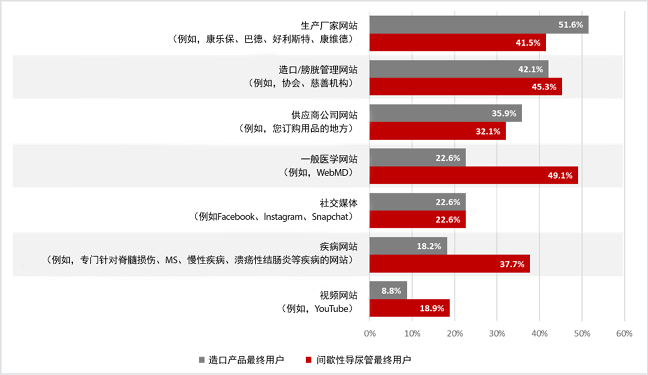
图4.在COVID-19疫情期间,造口产品和IC用户用于获取造口/膀胱管理信息或支持的互联网资源类型
注:在378名最终用户中,共有166名(44%)用户没有使用上述列出的任何资源。图中的百分比基于剩余的212名最终用户(159名造口产品用户和53名IC用户)。
患者计划支持
幸运的是,除了通过虚拟临床护理(如远程医疗)提供COVID-19支持外,还有其他虚拟服务可以帮助造口患者。患者计划或支持计划(如好利斯特Secure StartTM服务)能为造口患者和有失禁护理问题的患者提供急需的支持。这些服务在大流行期间一直没有中断,患者对服务的利用程度空前提高。虽然COVID-19使保持社交距离成为一种生活方式,但患者计划比以往任何时候都更致力于缩短患者与他们所需的教育资源和产品信息之间的距离。
在COVID-19疫情期间,网站也为造口患者和有失禁问题的患者提供了援手。由于许多患者都在线获取信息,因此在线上提供正确的信息至关重要 - 网站关注患者在此时期所需的信息可帮助患者获得积极的结局。例如,许多生产厂家的网站(如好利斯特COVID-19信息中心)均有专门关于COVID-19大流行期间HCP和最终用户需求的具体信息。
结论
总之,早期COVID-19研究表明,造口和失禁护理患者均受到大流行的负面影响。对于造口患者而言,造口周围皮肤问题仍然普遍存在。在失禁护理方面,UTI是IC用户的一个极大的担忧问题。对于这两种患者人群,远程医疗的使用率均较低。这对临床医生而言是一个机会,他们可以调整自己的实践,为患者提供虚拟支持这一选择。临床医生和最终用户均高度参与了研究,这有助于确定他们在这一大流行期间需要的具体支持和服务。由于这仅仅是全球大流行的开始,因此还需要更多的研究,包括在线支持或远程医疗对这些人群的有效性和满意度。作者鼓励读者进行自己的研究,并与更广泛的群体分享。COVID-19对我们每一个人都带来了独特的挑战,但只要我们齐心协力,就能够扭转乾坤。
伦理
通过匿名调查和伦理批准的临床研究开展研究。最终用户和临床医生调查不在伦理审查范围内。所有研究均获得参与者同意。
致谢
特别感谢George Skountrianos的统计支持。
利益冲突
作者为好利斯特公司的雇员。
资助
研究由好利斯特公司资助。
Author(s)
Karen Spencer*
BN, ET
Director, Global Clinical Education Ostomy, Hollister Incorporated
Email Karen.spencer@hollister.com
Stacy Haddad
MS, RD
Director, Global Clinical Affairs, Hollister Incorporated
Renee Malandrino
MSN, RN, CWOCN
Senior Clinical Scientist, Global Clinical Affairs, Hollister Incorporated
* Corresponding author
References
- World Health Organization [Internet]. 2010 [cited 2020 Aug 18]. Available from: https://www.who.int/csr/disease/swineflu/frequently_asked_questions/pandemic/en/
- Centers for Disease Control and Prevention [Internet]. 2016 [cited 2020 Aug 18]. Available from: https://www.cdc.gov/flu/pandemic-resources/basics/index.html
- Hollister Incorporated. COVID-19 survey with ostomy end users [internal data on file]. 2020 May.
- Hollister Incorporated. COVID-19 survey with ostomy clinicians [internal data on file]. 2020 May.
- Hollister Incorporated. Observational study of ostomy consumers: ostomy data registry clinical study 5878-O [internal data on file]. Available from: https://clinicaltrials.gov/ct2/show/NCT03715179
- Hollister Incorporated. COVID-19 survey with ostomy end users [internal data on file]. 2020 July.
- Hollister Incorporated. COVID-19 survey with intermittent catheter end users [internal data on file]. 2020 July.
- Ponto J. Understanding and evaluating survey research. J Adv Pract Oncol 2015 Mar–Apr;6(2):168–171.
- Gliklich RE, Dreyer NA, Leavy MB, editors. Registries for evaluating patient outcomes: a user’s guide. Section I: creating registries. 3rd ed. Rockville (MD): Agency for Healthcare Research and Quality (US); 2014 Apr. Available from: https://www.ncbi.nlm.nih.gov/books/NBK208643/
- Mann DM, Chen J, Chunara R, Testa P, Nov O. COVID-19 transforms health care through telemedicine: evidence from the field. JAMIA Open 2020 Apr.
- White T, Watts P, Morris M, Moss J. Virtual postoperative visits for new ostomates. CIN 2019 Feb;37(2):73–79.
- Salvadalena G. The incidence of stoma and peristomal complications during the first 3 months after ostomy creation. J Wound Ostomy Continence Nurs 2013;40(4):400–406. doi:10.1097/WON.0b013e318295a12b
- Malik TAM, Lee MJ, Harikrishnan AB. The incidence of stoma related morbidity: a systematic review of randomized controlled trials. Ann R Coll Surg Engl 2018 Aug;100:501-508. doi:10.1308/rcsann.2018.0126
- Nichols TR, Inglese GW. The burden of peristomal skin complications on an ostomy population as assessed by health utility and the physical component summary of the SF-36v2®. Value Health 2018;21(1):89–94. doi:10.1016/j.jval.2017.07.004


